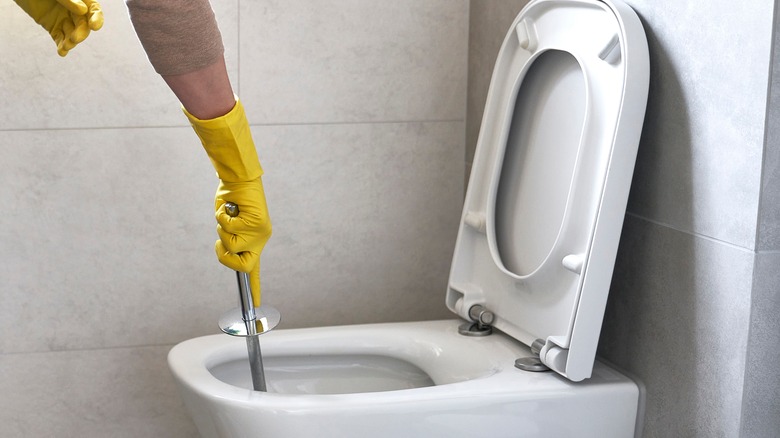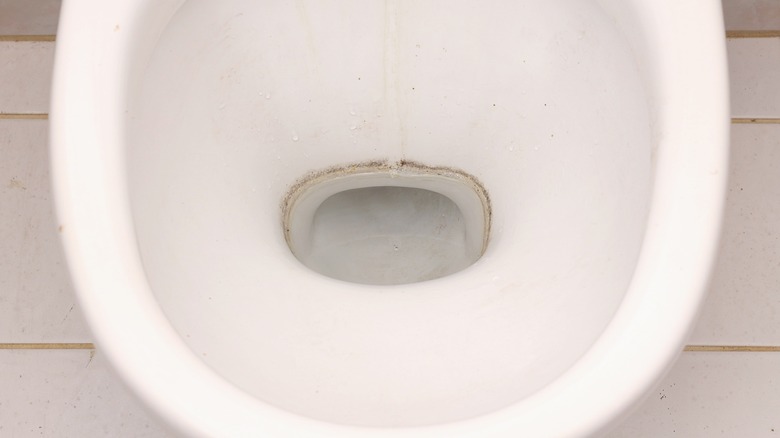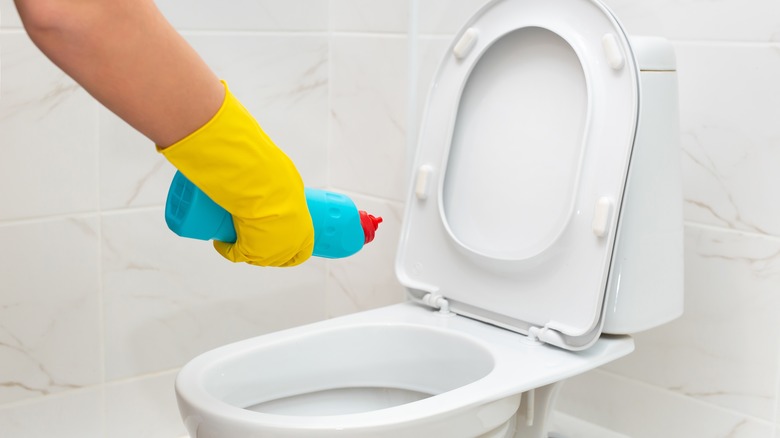Why There Are Pink Ring Stains In Your Toilet (And How To Get Rid Of Them)
Let's face it: cleaning the toilet is a drag, and getting stains out of the bowl is just plain gross. Stains can occur because the bathroom is the ideal climate for many airborne bacteria, one of which is called Serratia marcescens. This naturally-occurring bacteria can cause pink slimy stains at the waterline of your toilet, which can be slightly alarming when you don't know what's causing them. It's mainly the humidity in your bathroom that enables this bacteria to thrive, so there are ways to reduce its growth. You can typically get rid of the stains with a product that has bleach in it, and we've got the details for you. Rest assured, these stains have nothing to do with your water quality.
Bacteria in bathrooms is exacerbated by moisture. The more people in your household, the more showers that are taken and the more moisture that stays in the space. Plus, the average toilet seat harbors over 200,000 colony-forming bacteria alone. Every time it's flushed, a mist of water sprays up into the air, potentially contaminating items around it like your toothbrush. When you know there are pink frothy stains from possibly-harmful bacteria hanging around inside your toilet bowl, that's an even worse thought. This is why it's so important to remove these stains once you notice them.
About Serratia marcescens stains
Serratia marcescens produces prodigiosin, a naturally-reddish pigment that happens as a result of the bacteria multiplying and spreading. In fact, it's easily mistaken for blood before water dilutes it and turns it pink. It can also look black in some instances as well. This bacteria is commonly found on moist surfaces and especially in humid environments like bathrooms. Besides just the waterline of the toilet bowl, pink slime from this bacteria can also be found around bathtub walls and drains, sink drains, and shower doors. The bacteria love phosphates, dust, and moisture, all of which are commonly found in bathrooms.
Serratia marcescens can cause urinary issues, respiratory infections, endocarditis, wound infections, septicemia, eye infections, meningitis, and osteomyelitis. Further, most strains of this bacteria are resistant to multiple antibiotics. However, unless you're immune-deprived, this bacteria probably won't harm you, but it's still important to remove these stains when you see them. You can get rid of them with the help of specific cleaning products. It's also important to learn how to prevent these stains from forming.
How to remove and prevent these stains
One way to get rid of the so-called pink mold that's actually Serratia marcescens in your toilet is with a bleach-based cleaning product. For instance, you could use Lysol's Bleach Toilet Bowl Cleaner, found at Walmart for about $10. You should also always flush toilets on a regular basis, even if you don't use them often. Another terrific tip is using vinegar and water in a spray bottle to clean the waterline where the stains are. Keep in mind that using a metal scrub brush can scratch the sides of your toilet bowl, which could give the bacteria places to thrive. Instead, use a softer brush to scrub away the stains.
Alternatively, put on some rubber gloves and pour some bleach into a bowl. Grab an old toothbrush for cleaning purposes and dip it into the bleach before scrubbing the water ring stain in the toilet bowl with it. Do this repeatedly, cleaning each section little by little until all the stains are gone. You might need to clean more frequently to keep the bacteria from multiplying. To prevent these rings from occurring, try using a dehumidifier in the bathroom to reduce moisture. Turn the fan on when showering and crack the bathroom window to help air circulation.


